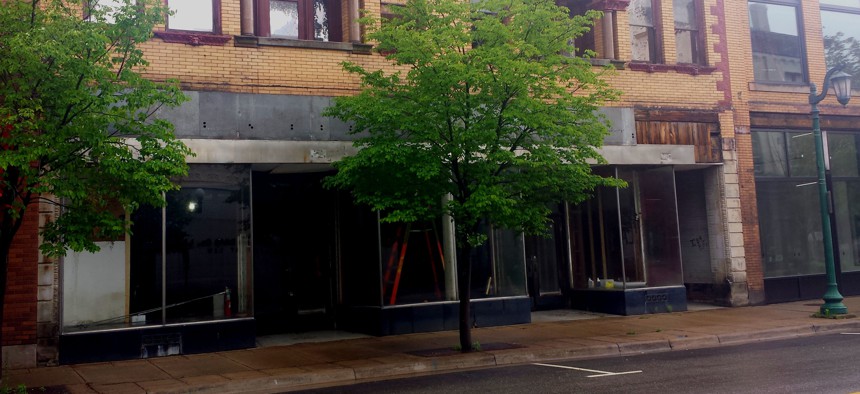Route Fifty Roadmap: East Liverpool, Ohio

A vacant building in downtown East Liverpool, Ohio. Michael Grass / RouteFifty.com
The vicious cycle of drug abuse, poverty and economic decline is eating away at the former Pottery Capital of the World. “Heroin is literally killing us.”
Route Fifty Roadmap is an ongoing series of dispatches from the semi-regular travels of the Route Fifty staff around the United States. | PREVIOUSLY: Wheeling, West Virginia
EAST LIVERPOOL, Ohio — There aren’t many good reasons to go out of your way to check out this faded industrial city just over the Pennsylvania state line and across the Ohio River from the tip of West Virginia’s northern panhandle, about an hour west of Pittsburgh.
If you’re driving to the Midwest from Washington, D.C., Baltimore or Philadelphia, the major freeways and turnpikes steer you well to the north or south of this place, once known as the “Pottery Capital of the World.” This city previously boasted hundreds of kilns and ceramics manufacturers from the mid-19th century into the early-20th century.
But just like in so many other industrial cities in the Upper Ohio River Valley, and elsewhere, East Liverpool’s economic fortunes changed. The ceramics industry is now mostly gone. (Fiesta dishware is still made across the river in Newell, West Virginia, at the Homer-Laughlin factory.)
In 1955, East Liverpool had a population of roughly 25,000 residents. Today, there are around 11,000 residents in the city, which like so many others in Appalachia and elsewhere around the U.S. has been struggling with poverty and the impacts of substance abuse, in particular, opioids like prescription painkillers and heroin.
East Liverpool is on the front lines of a growing public health crisis that’s consuming too many communities in the United States. As The Pew Charitable Trusts’ Stateline reported on Monday, drug overdoses are a disproportionate cause of death in Ohio, West Virginia and Pennsylvania, according to data from the U.S. Centers for Disease Control and Prevention.

I first stumbled across East Liverpool in June 2013 while on a transcontinental roadtrip following the route of the old Lincoln Highway from the East Coast to San Francisco. Crossing the U.S. 30 highway bridge or the narrow 111-year-old toll suspension bridge from West Virginia, the city is perched on bluffs above a bend in the Ohio River. Hills dotted with homes rise behind its commercial core.
While the city’s downtown, which boasts some very impressive commercial and civic architecture, is not devoid of activity, it felt very, very desolate during that first visit and has remained that way upon subsequent trips through the area. (I previously featured East Liverpool in my 2015 Route Fifty City-County Roadtrip series.)
On Saturday morning, I visited East Liverpool again. I picked up the local newspaper, The Review.

At the top of the front page was another reminder of the area’s problem with substance abuse.
On Thursday, the Columbiana County Drug Task Force executed a search warrant on a home on Lincoln Avenue and “turned up seven grams of heroin, needles, crack pipes, digital scales and other paraphernalia.” Four people were arrested.
On Friday, the drug task force searched a three-story building on St. Clair Avenue downtown around the corner from the fire department. The Review quoted the task force director, Brian McLaughlin, describing the building as “a heroin place.”

I checked out 614 St. Clair Ave. on Saturday morning. It’s a three-story building with empty retail spaces facing out onto the sidewalk. “For Rent” signs are posted in the floor-to-ceiling windows. The sidewalk curbs here, like so many others in East Liverpool are crumbling. Some of the building’s architectural ornamentation above the ground level is missing. A man in a black coat shuffled down the sidewalk and entered a doorway that presumably heads to the upper-level apartments, or the “heroin place” as the drug task force director described it to The Review.
It was previously the home of The Way Station, a ministry and social services non-profit organization trying to help local residents with job training, rental, utility and prescription assistance, food distribution and emergency kits for mothers leaving abusive relationships or others displaced by a disaster like a house fire. (The Way Station is now located elsewhere downtown.)
"Heroin is literally killing us," McLaughlin told a community gathering in March, according to The Review, which also reported that that a medic told the drug task force director that he didn’t recall the last time he worked a shift where there weren’t any drug overdoses.
That’s unfortunately a common experience for paramedics these days in so many places, from urbanized localities like Richmond, Virginia, to the suburbs of Portland, Maine, to distressed smaller cities like East Liverpool. Not too far away in Washington County, Pennsylvania, paramedics responded to 25 overdoses over the course of two days last summer.
And those incidents are just scratching the surface. The headlines from the frontlines of the opioid crisis keep on getting worse, though there’s hope that more policy attention on the issue from federal, state and local governments will lead to more help and solutions to assist struggling communities like East Liverpool, which also faces major environmental health challenges, too.
Drug abuse is is part of a vicious cycle of poverty, crime and economic decline in too many communities these days, especially in the Upper Ohio Valley. It’s too easy to look away from places like East Liverpool, dismiss them as hopeless and drive on by.
But to better understand the complex problems that are eating away at places like East Liverpool, you bypass them. There’s a lot of difficult work to do.
Next Stop: Ontario, Ohio
RECENTLY on Route Fifty:
Michael Grass is Executive Editor of Government Executive’s Route Fifty.
NEXT STORY: Need an ambulance? Better call Uber.






